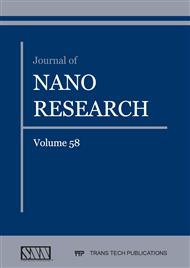[1]
D.A. Bazylinski, R.B. Frankel, Nat. Rev. Microbiol. 2 (2004) 217.
Google Scholar
[2]
C.T. Lefèvre, D.A. Bazylinski, Microbiol. Mol. Biol. Rev. 77 (2013) 497 LP-526.
Google Scholar
[3]
F. Fang Guo, W. Yang, W. Jiang, S. Geng, T. Peng, J. Lun Li, Magnetosomes Eliminate Intracellular Reactive Oxygen Species in Magnetospirillum Gryphiswaldense MSR‐1, (2012).
DOI: 10.1111/j.1462-2920.2012.02707.x
Google Scholar
[4]
S.S. Staniland, A.E. Rawlings, Biochem. Soc. Trans. 44 (2016) 883–890.
Google Scholar
[5]
A. Arakaki, H. Nakazawa, M. Nemoto, T. Mori, T. Matsunaga, J. R. Soc. Interface 5 (2008) 977–999.
Google Scholar
[6]
E. Alphandéry, Front. Bioeng. Biotechnol. 2 (2014) 5.
Google Scholar
[7]
C. Moisescu, I.I. Ardelean, L.G. Benning, Front. Microbiol. 5 (2014) 49.
Google Scholar
[8]
F.F. Guo, W. Yang, W. Jiang, S. Geng, T. Peng, J.L. Li, Environ. Microbiol. 14 (2012) 1722–1729.
Google Scholar
[9]
F.F. Guo, W. Yang, W. Jiang, S. Geng, T. Peng, J.L. Li, G.F. Fang, Y. Wei, J. Wei, G. Shuang, P. Tao, L.J. Lun, Environ. Microbiol. 14 (2012) 1722–1729.
Google Scholar
[10]
F.F. Guo, W. Yang, W. Jiang, S. Geng, T. Peng, J.L. Li, Environ. Microbiol. 14 (2012) 1722–1729.
Google Scholar
[11]
M.E. Maffei, Front. Plant Sci. 5 (2014) 445.
Google Scholar
[12]
Z. Ren, X. Leng, Q. Liu, Water Sci. Technol. (2017).
Google Scholar
[13]
Y. Wang, W. Lin, J. Li, Y. Pan, Front. Microbiol. 4 (2013).
Google Scholar
[14]
H. Wang, X. Zhang, Int. J. Mol. Sci. 18 (2017) 1–20.
Google Scholar
[15]
C. Dahmani, Static and Dynamic Magnetic Fields for the Nanoparticle Based Site-Directed Drug Delivery, (2014).
Google Scholar
[16]
R. Popa, W. Fang, K.H. Nealson, V. Souza-Egipsy, T.S. Berqú, S.K. Banerje, L.R. Penn, Int. Microbiol. 12 (2009) 49–57.
Google Scholar
[17]
E.G. Kıvrak, K.K. Yurt, A.A. Kaplan, I. Alkan, G. Altun, J. Microsc. Ultrastruct. 5 (2017) 167–176.
Google Scholar
[18]
M. Domenech, I. Marrero-Berrios, M. Torres-Lugo, C. Rinaldi, ACS Nano 7 (2013) 5091–5101.
DOI: 10.1021/nn4007048
Google Scholar
[19]
V.N. Binhi, F.S. Prato, Biological Effects of the Hypomagnetic Field: An Analytical Review of Experiments and Theories, (2017).
DOI: 10.1371/journal.pone.0179340
Google Scholar
[20]
A. (Scenihr), Opin. Sci. Comm. EU (2009).
Google Scholar
[21]
M. Circu, T.Y. Aw, Free Radic Biol Med. 2010 48 (2010) 749–762.
Google Scholar
[22]
M.-O. Mattsson, M. Simkó, Front. Public Heal. 2 (2014) 132.
Google Scholar
[23]
M. Simko, Cell Type Specific Redox Status Is Responsible for Diverse Electromagnetic Field Effects, (2007).
DOI: 10.2174/092986707780362835
Google Scholar
[24]
J.-B. Sun, F. Zhao, T. Tang, W. Jiang, J. Tian, Y. Li, J.-L. Li, Appl. Microbiol. Biotechnol. 79 (2008) 389.
Google Scholar
[25]
Y. Liu, G.R. Li, F.F. Guo, W. Jiang, Y. Li, L.J. Li, Microb. Cell Fact. 9 (2010) 99.
Google Scholar
[26]
D. Schüler, E. Baeuerlein, J. Bacteriol. 180 (1998) 159–162.
Google Scholar
[27]
F. Fang, Y. Li, G.-C. Du, J. Zhang, J. Chen, Sheng Wu Gong Cheng Xue Bao 20 (2004) 423–428.
Google Scholar
[28]
H.U. Bergmeyer, J. Bergmeyer, M. Grassl, Methods of Enzymatic Analysis, Verlag Chemie, Weinheim; Deerfield Beach, Fla., (1983).
DOI: 10.1016/0014-5793(84)81399-x
Google Scholar
[29]
C. Yingqing, L. Zhongxiong, S. Jinshan, C. Yiting, L. Guoqing, L. Yuling, Z. Wenlu, CHINESE J. Trop. Crop. 27 (2006) 29–33.
Google Scholar
[30]
D. Schüler, R. Uhl, E. Bäuerlein, FEMS Microbiol. Lett. 132 (1995) 139–145.
Google Scholar
[31]
L. Zhao, D. Wu, L.-F. Wu, T. Song, J. Biochem. Biophys. Methods 70 (2007) 377–383.
Google Scholar
[33]
Ö. Çelik, N. Büyükuslu, Ç. Atak, A. Rzakoulieva, Pol J Env. Stud 18 (2009) 175–182.
Google Scholar
[34]
J. Li, Y. Yi, X. Cheng, D. Zhang, M. Irfan, Bot. Stud. 56 (2015) 1–20.
Google Scholar
[35]
J. Li, Y. Yi, X. Cheng, D. Zhang, M. Irfan, Bot. Stud. 56 (2015) 2.
Google Scholar


